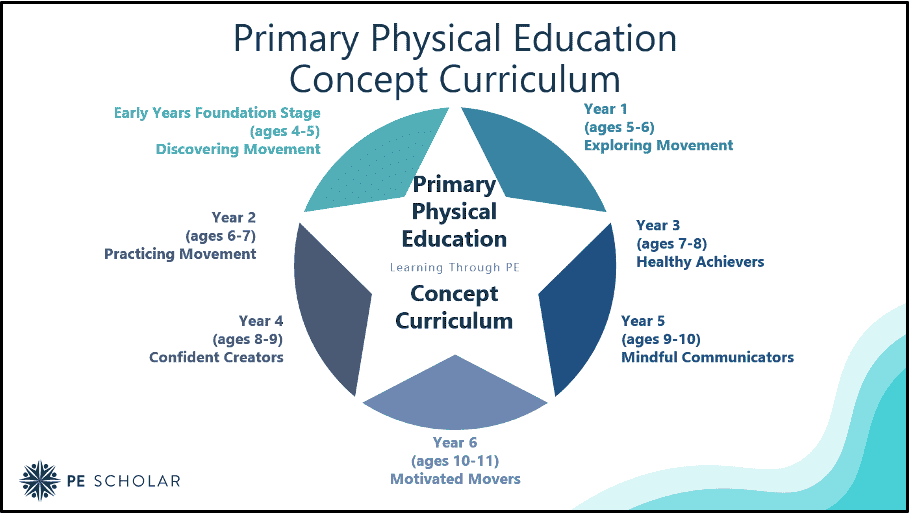
Introduction
In this blog, and in the supporting video below, we’ll take you through a detailed walkthrough of how to lead a PE lesson for early years using the Primary Concept Curriculum framework. This curriculum is designed to engage young children and provide them with a solid foundation in physical education. We’ll focus on Lesson 1 from the Galactic Explorers unit, emphasising the importance of navigating space for early years in PE.
The Primary Concept Curriculum Framework
The Primary Concept Curriculum provides a structured framework for delivering PE lessons that encompass both movement skills and essential concepts. Here’s a breakdown of the framework:
- Lesson Introduction:
- Begin with a quick introduction to the concept and story.
- Provide an overview of what the lesson will cover.
- Engage the children in the story and concept to spark their interest and curiosity.
- Energise, Explore, and Link Activity:
- The first physical activity introduces the concept and gets children active.
- Encourage questions and discussions to connect their thinking with the activity.
- Foster an immersive learning experience by making it fun and engaging.
- Activity:
- Early years and key stage one students engage in three activities that promote learning through physical and cognitive domains.
- Develop a positive relationship with physical activity while building fundamental movement skills.
- Discovery:
- End the lesson with discovery questions.
- Encourage students to reflect on what they’ve learned, its importance in PE, and how it can be applied outside of PE.
Lesson 1: Join the Mission
In Lesson 1 of the Galactic Explorers unit, the objective is to introduce children to the routines and importance of PE. The key objectives are:
- Know: Understanding important routines for PE.
- Show: Grasping the concept of navigating space and avoiding obstacles.
- Grow: Promoting safety, respect, and fun in physical education.
Opportunities to Develop Physical Competence in the Lesson
This lesson will provide multiple opportunities for children to develop fundamental movement skills within the suggested activities. Here is a brief summary:
Locomotor: Children will move around the activity space at different speeds and performing various movements (walking in space, running from aliens, crawling under legs, etc.).
Balance: In this lesson, children will be asked to stand on one foot (pretending to place space boots on), stretch out arms, freeze in one position, etc.
Object Control: In the final activity, children will attempt to stop a balloon from hitting the floor. This will provide the opportunity to consider striking, placement and develop hand-eye coordination.
Lesson Introduction
Engage the children by immersing them in the story of joining a space mission. Use the character and script to make it more captivating. Ask questions to involve them in discussions about safety, respect, and fun in PE. Start with an activity to prepare for space, such as “astronaut training.” Encourage children to perform actions like balancing on one foot, extending their arms, and moving as if they’re in space. Emphasise safety and fun.
Energise, Explore, and Link Activity
Next, introduce the energise, explore, and link activity. In this case, it’s “space walking” where children pretend to walk on the moon, promoting spatial awareness and safe navigation. Freeze moments can be added for balance and coordination practice.
Activity 1: Control Centre
Introduce the activity with keywords related to the story. Children follow instructions to perform different movements related to space. Highlight safety, respect, and fun aspects throughout the activity. Adapt the challenge level as needed.
Activity 2: Light Speed
Continue the story with a character or script. In this activity, children engage in “light speed” crawling on the floor. Emphasise safety by keeping legs outstretched and being respectful by allowing others to pass underneath. Make it enjoyable and engaging.
Activity 3: Zero Gravity
Explain the concept of zero gravity, emphasising its importance in space exploration. Use a balloon to create a fun activity where children work in small groups to keep the balloon from touching the floor. Encourage communication, collaboration, and safe interaction with the environment.
Discovery
End the lesson with discovery questions:
- What did we learn today?
- Why is it important in PE?
- How might we use these skills outside of PE?
Leave them excited about the next lesson and the adventures to come.
Conclusion
Navigating space is a crucial concept in early years PE. The Primary Concept Curriculum provides a structured and engaging framework to introduce this concept while fostering safety, respect, and fun in physical education. By immersing children in a captivating story and providing a variety of activities, we can lay a strong foundation for their physical, cognitive, and social development. So, get ready to embark on your own PE mission with young explorers and watch them grow in their understanding of space, movement, and more!
Further curriculum ideas and resources
At PE Scholar we aim to provide high-quality materials and expert knowledge to make your teaching that bit easier. Below are some further resources and insights to support you with your PE curriculum.
More Lesson walkthroughs: Year One, Year Two, Year Three, Year Four, Year Five and Year Six
The Primary Concept Curriculum insight
PE curriculum design guest blog
Concept curriculum lesson templates
Concept curriculum non-performer worksheet
Mapping your PE Curriculum resource
Conceptual PE: a course for the future research publication
Purchase the Concept Curriculum – Primary and Secondary


[…] walkthroughs: Early Years, Year One, Year Two, Year Three, Year Four, Year Five and Year […]
[…] Lesson walkthroughs: Early Years, Year Two, Year Three, Year Four, Year Five and Year […]
[…] Lesson walkthroughs: Early Years, Year One, Year Three, Year Four, Year Five and Year […]
[…] Lesson walkthroughs: Early Years, Year One, Year Two, Year Four, Year Five and Year […]